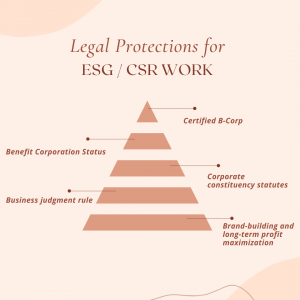Part 2: Fiduciary Duties to Shareholders, Partners, and Members
28 What is a certified B-corp?
One challenge with building a brand based on social responsibility is the problem of believability: should customers trust you are doing what you advertise? One solution to this is to have a third-party certify that you are following a set of practices. This is the concept of a “certified B-corp”. It is not another name for a benefit corporation, and it is not a new legal method for incorporating a business. Instead, it is a third-party review of a company’s ESG/CSR practices that provides outsiders with some confidence that the company is following its stated practices.
This certification can be expensive, costing over $50,000 a year for large companies. It also involves an extensive review process, which can be costly for companies to comply with and take several months to complete. The beginning of this process is to form a legal entity which will best allow consideration of social issues without risking litigation. For states that allow benefit corporations, becoming a benefit corporation is the first step. In other states, language is given to add to a company’s Articles of Incorporation that attempts to accomplish the same purpose, such as adding a “purpose clause” and provisions requiring board members to consider the effects of their actions on employees, the environment, communities, and so on.

King Arthur Flour is also a certified B-corp. You can view its certification here. This document details governance, treatment of workers, impacts on community, the environment, and customers. Each of these areas area given a numeric score, and then combine to form a total score. In theory, these scores are comparable between companies in a way that would help consumers choose the most socially responsible corporations (as measured in the certification process).

Exercises
- Find a certified B-corp and examine its report. What stands out to you? Compare the quantitative aspect of the report with a second certified B-corp and note what inferences you may draw.

